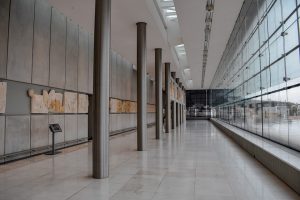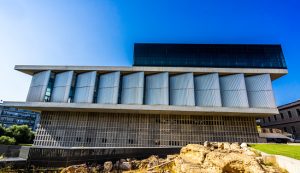The design and creation of the New Museum of the Acropolis

The Acropolis Museum museum occupies a total of 23,000 sq.m., with exhibition spaces 14,000 sq.m., with ancillary public areas such as amphitheater, periodical exhibition hall, restaurant, two canteens, museum shops, living room with Internet connection and other spaces such as offices, laboratories, engineering facilities, warehouses and parking lots for museum workers on four underground levels.
In the trapezoidal free area allocated for the Museum, in the building block of Makrigianni, the parthenon room changed axis by 23 degrees, so that the frieze receives light in the same way as when it was formed by Pheidias’s team.

The new parthenon atrium became the tip of a light funnel that, passing through the transparent floors, joined the classic frieze with the archeological excavations.
These are parts of preserved collections from Hellenistic, Roman or Early Byzantine times (up to the seventh century). They do not include public buildings or mansions, but they prove the permanent habitation of the area.
The glass in the Acropolis Museum is specially clean with low levels of iron to avoid green. The parthenon room is surrounded only by self-supporting glass on two surfaces with a distance of 70 cm between them.
The interior hangs at 2.25 m from the floor. The exterior has silkscreen dots for shading and glare reduction. A coating protects against infrared radiation, is converted into heat. Special fabric shading rollers with sensors protect three facades. The north side, towards the parthenon, is the clearest.
The double glazing creates a “glass chimney” of the hybrid air conditioning system. The perimeter glass base bench is at the same time an air conditioning duct that blows icy air to the floor. The air rises to the false ceiling of the air conditioner. When the outside temperature is 40 ° C, inside it remains 23 ° C.
The glass floors provide the view of the archeological excavations under the museum. It is 5 cm thick laminated glass for temperature resistance and is not sliperry.
